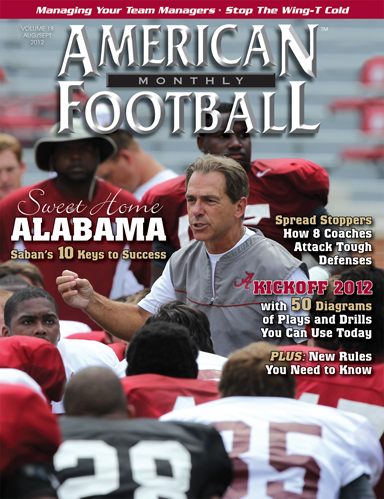Article CategoriesAFM Magazine
|
Reliable Performerby: AFM Editorial Staff© More from this issue A Houston-area high school chose the HME DX300 sideline communications system to deliver superior performance in critical game situations. In the super-competitive world of Texas 5A high school football, coaches must pay close attention to every detail of program management – on and off the field – in order to achieve winning seasons. Decisions about which coaching technology to use, for example, can be just as important as which offense to install or which player to start at middle linebacker. At Elsik High School in the Alief school district in Houston, the most important decision coaches faced after the 2010 season was how to improve their communication. It was not that the coaches had not developed a specific plan for communication between the coaches on the sideline and those in the press box, it was that their headset system had failed them at critical points during the season. In pressure-packed Texas football, where every play matters, that was simply unacceptable. The job of finding a new system fell to Elsik’s Offensive Line Coach and audio-visual manager Paul Delesbore, a 20-year coaching veteran. Delesbore sought recommendations from other coaches, compared features and prices, and spoke to company representatives before ultimately deciding on the DX300 headset communications system from HME. After using the system for the 2011 season, where Elsik captured a District Championship, his verdict on HME’s system is clear and powerful. “They are simply the best in the business,” he said. Elsik High School is not alone in making the switch to the DX300. High-profile schools in Texas and across the country have discovered the benefits of having a sideline communications system that is full of features and competitively priced – thanks to HME. “The DX300 system has been widely accepted by high schools and small colleges across America,” said Darcey Meddings, who, as HME’s Professional Communications Division Channel Manager, is responsible for overseeing the football market. “We listened to coaches and designed the DX300 specifically to meet their need for a reliable, easy-to-use system that fits into any program’s budget.” HME, based in the San Diego area, has only been marketing headset systems for football since 2008, but they have been a leader in wireless communication worldwide for over 40 years. “HME actually introduced the first wireless intercom system for professional users in 1979,” according to Rick Molina, HME’s Pro Audio Product Manager. “The technology we built into the DX300 system for football coaches takes advantage of our decades of experience. HME has worked in over 95 countries and we’ve been granted 29 patents.” For Paul Delesbore, the decision to replace Elsik’s previous system with HME’s DX300 was part of a trend. “I knew from my research that many top high schools in Texas, including Alief Hastings here in our district, had made the switch to HME,” he said. “Now, all three high schools in the Alief District are using the system with great results.” That’s no surprise, given the DX300’s exceptional performance and superior features. AFM recently had the opportunity to speak with Coach Delesbore about the importance of having a sideline communications system that can be counted on to perform in crucial game situations and the reasons why he chose HME’s DX300 system for the Alief Elsik High School program. |
|
| HOME |
MAGAZINE |
SUBSCRIBE | ONLINE COLUMNISTS | COACHING VIDEOS |
Copyright 2025, AmericanFootballMonthly.com
All Rights Reserved




